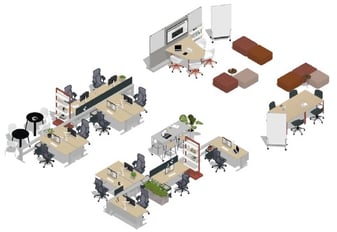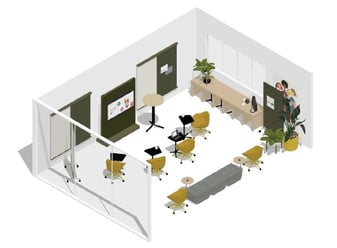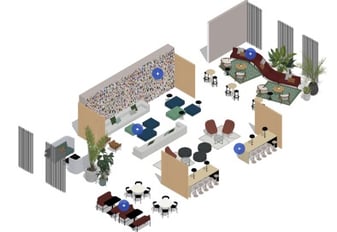What seemed an exception to the rule a couple years ago has quickly become the norm for many organizations. Hybrid work models are more common than ever before. In general, they consist of those who work in the office and those who work-from-home, with many choosing a hybrid office concept that combines both.
This type of flexible workplace has simultaneously provided benefits and created challenges for some business leaders. Many are left to consider how to use extra office space and accommodate the nomadic nature of their hybrid workforces.
If your organization is struggling to adapt to a hybrid work model, consider the following challenges and commercial interior solutions.
Organizations who’ve embraced remote workers as the rule and not the exception are left with seemingly empty hallways and office spaces. Paying the mortgage or rent and heating bills for space that sits idle most of the time seems like a major waste of resources.
A typical growing business isn’t necessarily ready to abandon their facility in search of a smaller one, however. Future growth and another potential shift in employee preferences might require use of that space at some point.
SOLUTION:
For employees who work in the office a majority of the time, consider upgrading their work environments to more spacious offices that were previously occupied by those who now work remotely. The added perk can be viewed as a benefit, a potential asset when trying to recruit and retain top talent. Other spaces can be turned into “hotel” suites with unassigned desks for those who are hybrid, allowing them to pick and choose where they feel they will be most productive on a given day. Be sure to also offer focus booths, retreats, and quiet zones for those who need deeper concentration. Throughout, equipping these spaces with flexible furnishings is critical to ensure maximum productivity and allow for reconfiguration down the road.
Source: Herman Miller
While many employees and employers report increased productivity when working remotely, three out of four employees say that collaboration has suffered the most. Survey participants also said that they missed casual in-office interactions that inspired spontaneous brainstorming or strategizing. A lack of collaboration could contribute to a decline in business opportunities and fewer progressive ideas that propel it toward greater success.
SOLUTION:
Providing additional interactive spaces where employees can connect, whether for scheduled meetings or spontaneously, fosters creativity and ideation. Meeting spaces need no longer be designated rooms with large conference tables encircled by chairs. Create several options for employees so they can choose which area will best suit their needs. Turn offices into smaller, casual meeting spaces, and also provide larger, open areas that allow for movement, creative expression, and ideation. Hybrid workplaces must explore how to use their office space and reconfigure it in ways that promote interaction. 
Source: Herman Miller
Quality internet connections for remote workers is a major issue for some, while disparities in technical capabilities and know-how challenge others. Technology limitations, lag times, and poor connectivity are inherent roadblocks to deeply engaging and interactive conversations, further hindering collaboration. Organizations that don’t seamlessly connect their in-office workers with those working remotely will inevitably create silos and diminish productivity.
SOLUTION:
Consider that some individuals may need help finding solutions for technical issues or require additional training. Adding video conferencing capabilities to offices and virtual conference rooms helps enhance meetings. Large screens and equipment that show everyone in the room (not just individuals on laptop screens) improve engagement. Invest in quality equipment so that those at home feel as immersive of an experience as possible. Casual seating placement — rather than gathering around a table — allows for easier viewing and interactions with those participating remotely.
For many, their coworkers are like family, and a hybrid model poses the risk of diluting a workplace’s culture. Establishing a healthy workplace culture is difficult enough when everyone is on equal footing in the office. Dividing a workforce between in-office and at-home employees makes that task even more difficult. It’s all too easy for remote employees to feel disconnected or left out of activities taking place in the office. Creating a robust culture is perhaps one of the greatest challenges employers face when embracing a hybrid work model.
SOLUTION:
More attention than ever needs to be focused on workplace culture. Consider how technology can aid in this area, and be deliberate about engagement and creating virtual experiences for those who aren’t in the office. For hybrid employees, be sure to assign areas in your workplace where they can engage with others when in the office. Updating break rooms, creating comfortable seating areas, and adding welcoming furnishings to offices lets employees know that they’re encouraged to take the time to reconnect. Also consider how to remain flexible by configuring spaces for holiday parties, office celebrations, and other social gatherings.
Source: Herman Miller
A survey of 2,000 hybrid workers showed that about half reported an increase in lower back pain, shoulder pain, and eye strain. A majority report cutting their mobility by as much as 50% since starting to work from home, and about half say they take less than 1,000 steps during the work day. The impact of sitting in isolation all day isn’t just physical; seven in 10 employees who work from home feel more isolated, disengaged, and disconnected. More than one in three say they miss the simple things like in-person meetings and office get-togethers.
Providing ergonomic furniture solutions for all employees — even those who work remotely — is quickly becoming a priority. Employers realize the potential negative effects that poor health and mental wellbeing can have on their workforce’s satisfaction, productivity, and eventual healthcare costs. Encouraging breaks throughout the day and offering a stipend for ergonomic office chairs, standing desks, or other productivity tools might be in order. Maintain open communication with employees to gauge their wellbeing and provide support as needed.
Expert designers and commercial office furniture solution specialists can guide organizations through how to reconfigure office spaces and offer hybrid workstations and furnishings. Download our helpful Hybrid Work Model Guide to Commercial Interior Solutions to view real-life examples and additional recommendations.
Then, contact the commercial furniture solutions and construction experts at The Samuels Group for more ideas and explore how to create a workplace that is conducive to the hybrid work environment.
These stories on Furniture Solutions